Nota del Editor: Para leer la versión original en inglés de esta historia, haga clic aquí.
It was the last day of March of 2018, the day before Easter, the season of onions. By mid-morning, 16-year-old Berenise had already loaded a few pails. She held sharp, rusty shears that demanded careful precision; one slip, and they could take a finger. Berenise worked alongside her 10-year-old brother, Salvador, and her parents a few paces away. Sunlight beamed across mile after mile of flat green fields, broken only by a few dirt roads. When it’s harvest time like this, multigenerational families, from young children to grandparents, cluster among the furrows. The land is scattered with plastic pails, packing crates, and a few blue porta-potties. Onions blanket the ground, as far as the eye can see; the air smells sweet and sharp. Human backs form U-shaped curves of habit, heads covered in hats and hoods, pants and fingers stained with chlorophyll and mud.
This particular scene unfolded near McAllen in the far southern tip of Texas along the United States–Mexico border, but it repeats itself, in field after field, day after day, across more than a million acres of farmland in the Rio Grande Valley. It goes on and on until daylight fades or the very last vegetable is picked and crated—whichever comes first. In this field, Berenise and her brother had developed a routine: grasp an onion, shake the dirt, cut the greens, snip the roots, toss the onion into a bucket; when the bucket is filled, lug it to a plastic crate as tall as their hips, hoist the pail, and dump the load. A full crate earned the family $16.
“If you work hard, it’s good,” said their father, Salvador Sr., 43, who was willing to publicly share most every detail of his life and his job, except his family’s last name—because he and his wife are undocumented immigrants from Veracruz, Mexico. “The work in the fields—it’s rough,” he said. He had been doing it for the last three years after his work as a mechanic fell through; since then, he has worked the fields and taken jobs fixing cars on the side for extra cash. “If I had documents, I would have a steady job.”

The Young Hands That Feed Us, by Karen Coates & Valeria Fernández. Listen to more Pacific Standard stories, read out loud.
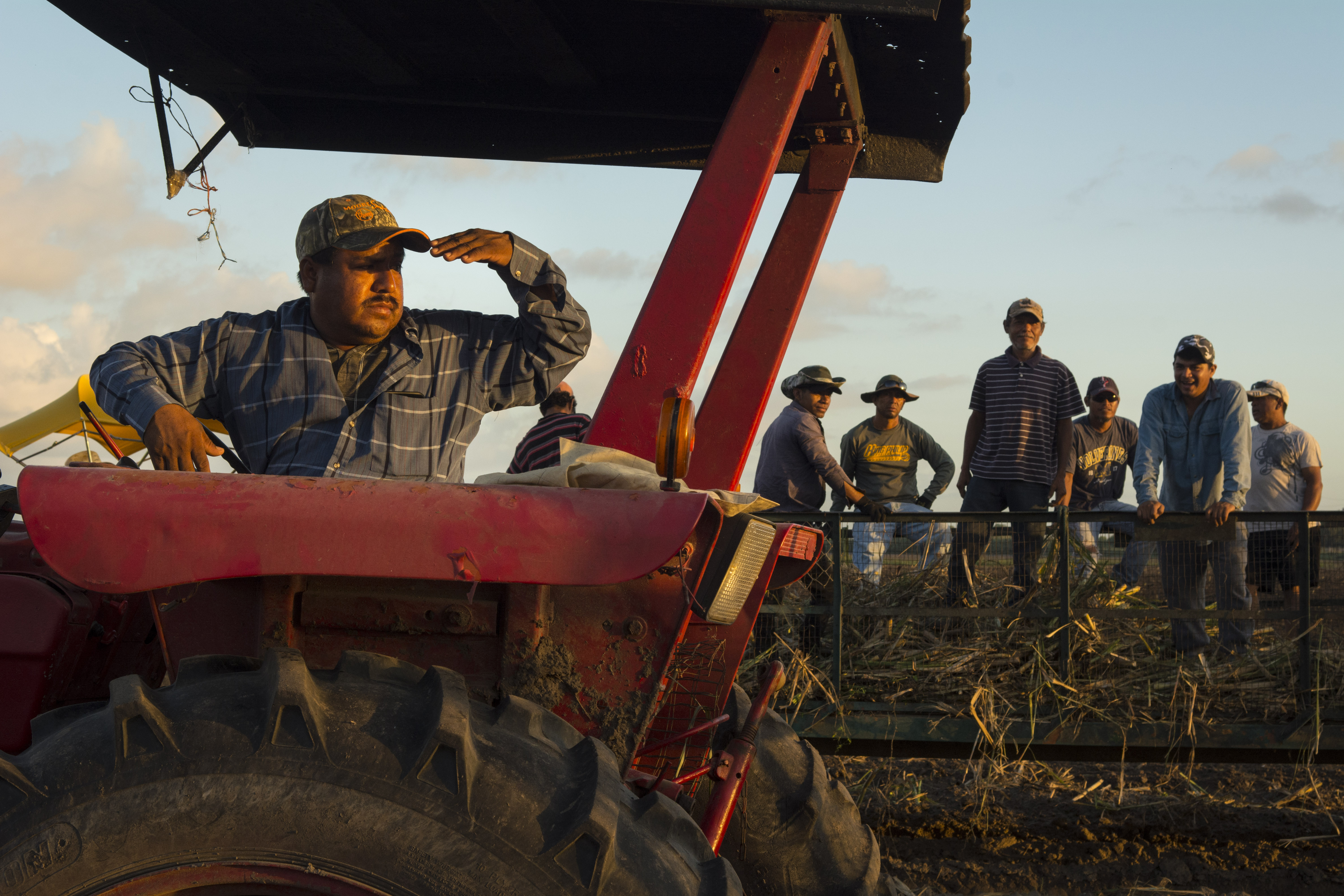
(Photo: Jerry Redfern)
This job—farmwork—is a job that no one wants. It’s the definition of stoop labor, and it frequently leads to life-altering consequences. “I worked like a donkey all the time,” recalled an 85-year-old grandmother named Juliana Martínez, who spent most of her life in the fields. She began as a child in Mexico, then worked for decades in South Texas. She felt no pain. “Maybe when I get older, it will start hurting,” she laughed. But she was lucky: among farmworkers, injuries are common, sometimes disabling, occasionally fatal. More than that: workers talk of astoundingly high rates of cancer, diabetes, Parkinson’s, Alzheimer’s, birth defects, and early deaths—and they all suspect pesticide exposure is a culprit.
Still, across the U.S., up to three million people do this work (estimates vary widely; there is no concise, accurate tally of the total number of farmworkers in the U.S.). “The only reason they’re out there harvesting those crops,” says Juan Anciso, professor at Texas A&M AgriLife, an agricultural research and extension service in Weslaco, “is because they don’t have an alternative.” They don’t have the education or job skills needed to pull them out of farmwork, he says. And the food industry, in many cases, has few alternatives either; there are no machines to pick many of the most delicate greens, vegetables, and herbs. The work requires human hands. It’s hard, monotonous labor that supports an industry worth approximately $990 billion—and feeds the nation. Many Americans, maybe most, don’t think about that, Anciso says. “You go and have your salad but don’t realize someone’s breaking their back to harvest that.” Most shocking of all, hundreds of thousands of these workers are minors—and it’s perfectly legal.

(Photo: Jerry Redfern)
It’s actually hard to measure precisely how many children are working on U.S. farms (partly because different agencies use different criteria and different ages in their measurements), but a 2014 Childhood Agricultural Injury Survey puts the number at 524,000.
There was a steady breeze that day in the onion field, which helped to cut the heat. Still, Berenise’s brow was dotted with sweat. Occasionally, semis growled past on the nearby highway, but mostly the field was quiet except for the snip snip snip of scissors and the crumbling of dirt granules as they fell from the onions to the ground. Talk is time, and time is money—so words were scarce. But Berenise paused for a moment to say she was looking forward to Easter Sunday and a break from the fields. “We’re gonna go to the zoo, the whole family,” she said. “I haven’t gone in a long time because my parents are always working.”

The next morning, all across the valley, the fields were empty, the churches full. Just a few miles away from the onion field in the town of San Juan, the Martínez family—four generations strong—gathered for a backyard fiesta of chicken and rice, beans and salsa, and games of musical chairs. “No Rompas Más (Mi Pobre Corazón),” a Spanish-language cover of “Achy Breaky Heart,” blasted from outdoor speakers. Juliana Martínez passed out eggshells she had painted and filled with confetti and baby powder. It’s a Mexican tradition she learned in her hometown, and she’s done it since she was six years old. Suddenly, everyone leapt into action, smashing eggs on heads, leaving the crowd, the house, the trees powdered and speckled in a pastel rainbow.

(Photos: Unsplash & Getty Images; Illustration: Ian Hurley/Pacific Standard)
Juliana was born across the border but has lived most of her life in Texas as a farmworker, then as a farmworker’s wife, a mother of nine. She used to take her kids to the field, putting them in a little tent in the shade while she worked in cotton, carrots, chiles, and beets from 7 a.m. to 6 p.m. Back then, when the blistering summer heat of South Texas arrived, the Martínez family would migrate to the Midwest with its cooler fields. They’d follow the seasons, traveling north from town to town, picking one crop here, another there.
More than 300,000 children across the U.S. migrated to follow the harvest during the 2016–17 school year, according to the U.S. Department of Education. Each spring, beginning in March or April, many of those students leave their schools, moving with their families, packing just the essentials—sacks of beans and rice, a few sets of clothes, all stuffed into trucks that roll across county and state lines. As one worker put it, “Like the birds that fly, we go.” Any child who migrates more than 20 miles is supposed to receive access to the federally funded Migrant Education Program, which aims to coordinate their studies at home with their schooling wherever their family lands for work. But many kids fall through the cracks. They don’t finish out their classes at the end of the year, and they don’t return until September or October.
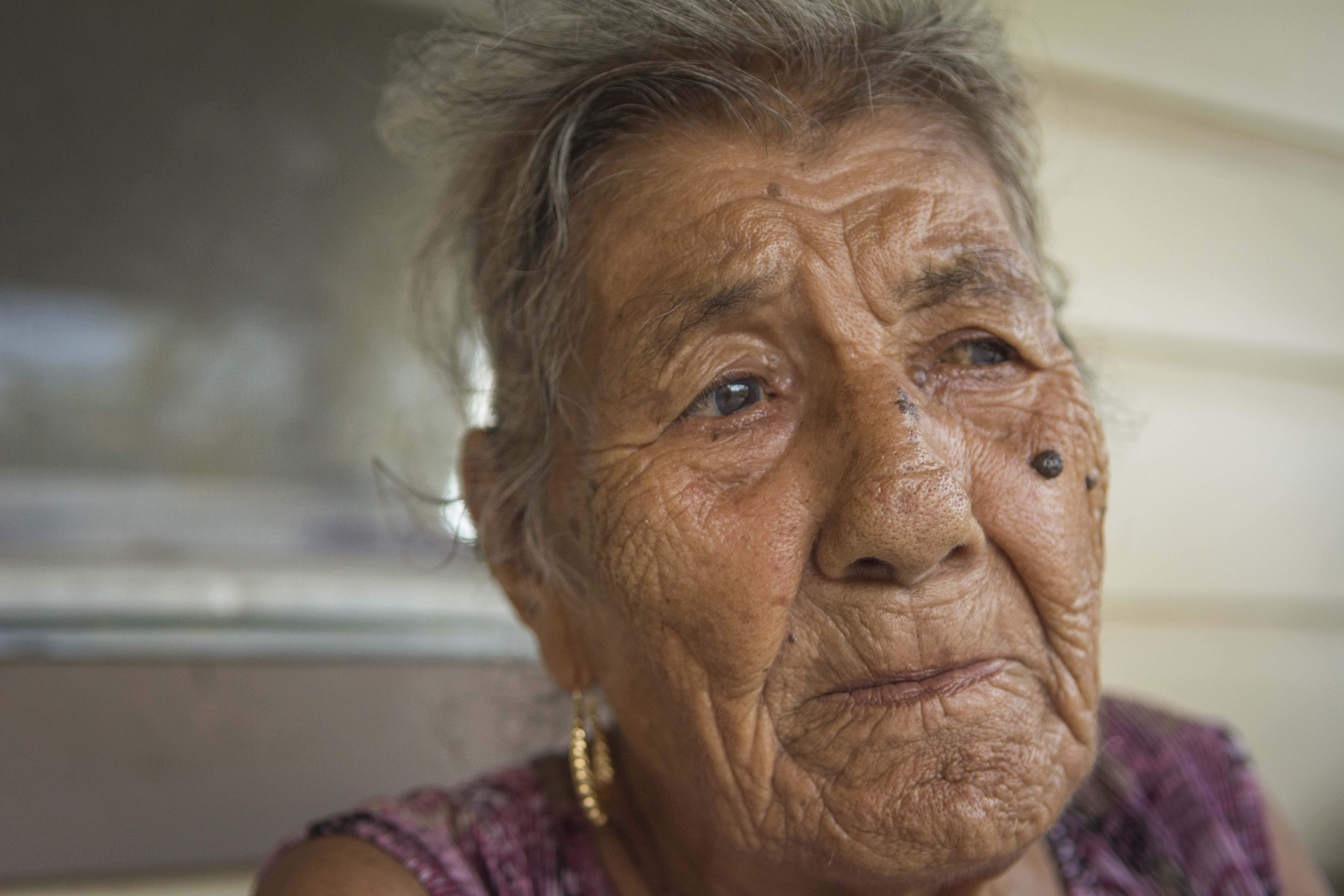
(Photo: Jerry Redfern)
Juliana’s daughter María said that her father never saw the value of education; he saw the value of work. In her first days in the field at eight years old, she was given an ice cream bucket to fill with cucumbers for pickling. She earned money for her family and moved with them around the state, season to season. By the eighth grade, she had dropped out of school. Now, at 55, María was a field supervisor for Rio Fresh, the same position with the same company where her father had worked. After nearly half a century in the fields, she was making $8.50 an hour.
“It’s perfectly legal for children at the age of 12 to work unlimited hours on a farm of any size as long as they don’t miss school and they have their parents’ permission,” says Margaret Wurth, senior researcher in the Children’s Rights Division of Human Rights Watch. The federal minimum age for work in most industries is 14; in agriculture, it’s often 12. But in many cases, children of any age can work. “There’s actually no minimum age for children to work on their own family’s farm.” This variance is allowable because agriculture is largely exempt from the U.S. Fair Labor Standards Act, which establishes national requirements for wages, overtime pay, and youth employment.
According to the U.S. Government Accountability Office, “children of any age” may be employed “in any agricultural occupation at any time,” so long as they are officially employed by a parent (or a person standing in place of a parent) on a farm “owned or operated by that person or parent.”
Human Rights Watch argues that farmwork in the U.S. should be considered one of the “worst forms of child labor” as outlined by the International Labor Organization. The agricultural exemption from the FLSA not only allows children to work longer hours, at younger ages, than in any other industry in the U.S., but it also allows children to work in more hazardous conditions, according to HRW. In agriculture, 16-year-olds can perform tasks the Department of Labor deems “particularly hazardous”; for all other industries, the minimum age is 18.
The U.S. is distinctive when it comes to child labor in agriculture. Wurth has done much of her research in Brazil, Indonesia, and Zimbabwe, and has found significant differences. “What distinguishes the U.S. from all of these countries is just how weak the law is,” she says. “None of these other countries allow children legally at the age of 12 to work as hired workers on farms…. It’s kind of unbelievable that, in 2019, that’s the status of our child labor laws when it comes to farming.”
As a result, roughly 33 children are injured in agriculture-related accidents every day, according to numbers kept by the National Children’s Center for Rural and Agricultural Health and Safety. A GAO report released last November indicates that children who work in agriculture accounted for less than 5.5 percent of all working children in the country during any year from 2003 to 2017, yet they accounted for 52 percent of all work-related child fatalities across all industries from 2003 to 2016. The report documents 237 such deaths among children in agriculture between 2003 and 2016—an average of roughly 17 fatal accidents per year.
Though health and human rights advocates decry the dangers of agricultural work for children, solutions are not as simple as banning the practice. For some families, the work is not only essential to their livelihood; it’s also tradition. Families bond; children learn to contribute to their family’s struggle to survive. But the agricultural industry has also learned to capitalize on this shared work ethic. The national minimum wage is $7.25 an hour, and most industries require overtime pay for days longer than eight hours, but many farmworkers, children and adults alike, are exempt from these conditions of Fair Labor laws because some farms, typically smaller operations, are exempt from the FLSA entirely. Instead, farm jobs often still pay “piece rates.” Onions: $16 per crate. Cilantro: $3 per box of 100 bunches. Collards and kale: $3 per box of 72 bunches. By law, those piece rates are supposed to equal or exceed minimum wage when factoring in hours worked—but they often don’t, according to farmworker advocates in the area.
“Poverty is the determinant of whether a child is going to be working in the fields,” says Norma Flores López of the East Coast Migrant Head Start Project who chairs the Child Labor Coalition’s Domestic Issues Committee. “If you really want to be able to get rid of child labor, if you really want to address the root causes, pay the parents enough. Give them a fair living wage.”

In Edinburg, Texas, Reyes was nearing the end of his academic year. On May 10th, at 4 a.m., the high school sophomore would pack 13 pairs of socks, a half-dozen pairs of jeans and T-shirts, rubber boots, plastic pants, and raincoats, and he would start the three-day trip in a truck from his home in South Texas to Hart, Michigan, to work for five months in the asparagus fields and other farmland. He would be hand-picking and sometimes even working the soil by hand, breaking clods and removing rocks to prepare a field for planting. “I’ve suffered a lot, but you know what: I need to help my family,” Reyes said. He was 16 years old, transitioning from his rounded childlike face to one with shaved sideburns and the shadow of a mustache. “If I don’t do it, who is gonna do it?”
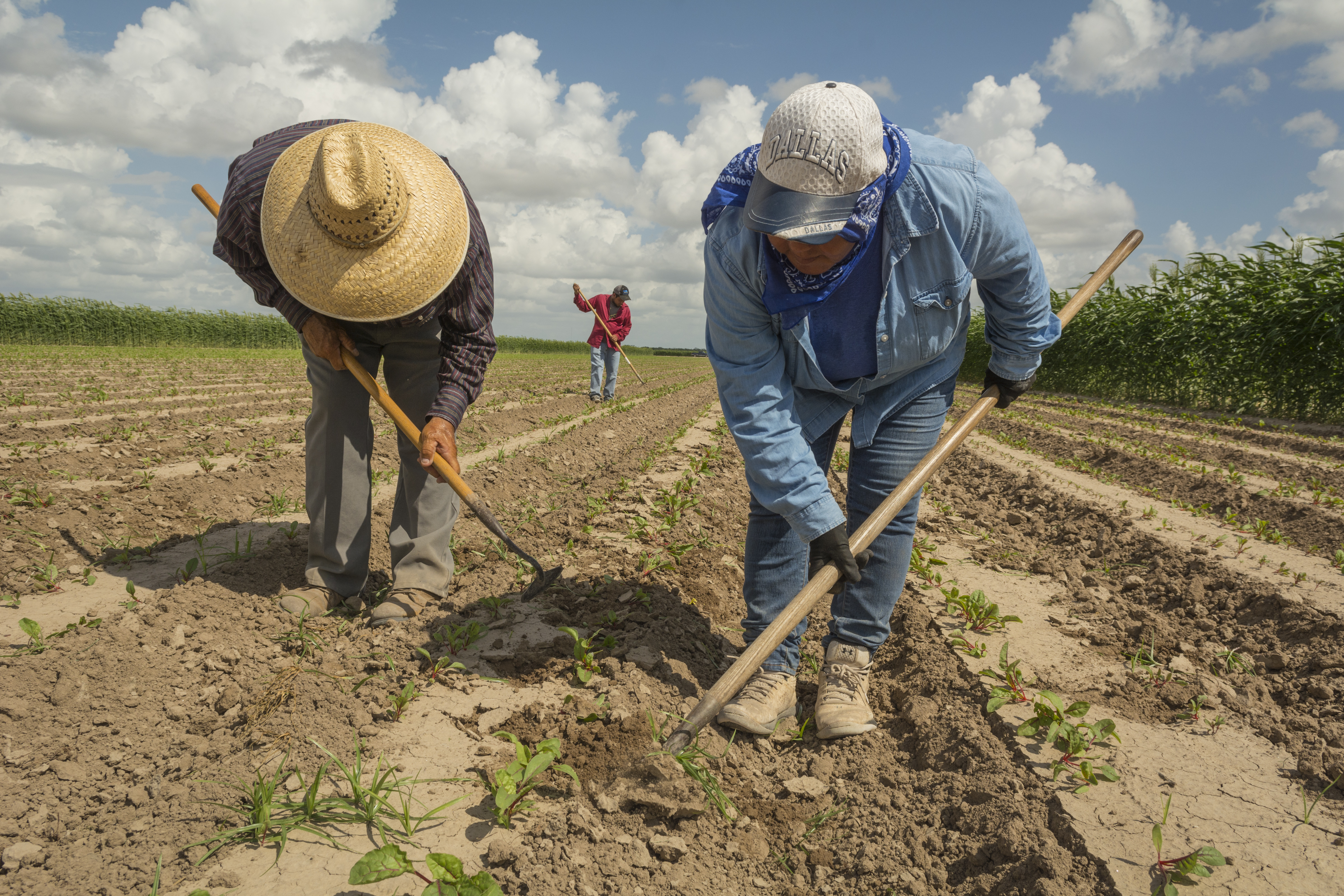
(Photo: Jerry Redfern)
Reyes started going to Michigan in 2011, when he was just nine years old, accompanying his mother, María Magdalena, and her husband, Carlos, who is like a father to him. María Magdalena is still in the process of getting legal documents in the country, which is why she asked for only their first names to be used in this story. Working the fields is a family affair. “It’s important to be together with your family,” Reyes said, “to take care of each other, watch each other’s backs.” María Magdalena worked on a motorized machine, snapping off asparagus with her fingers, and Reyes walked behind, picking up any stalks she dropped or couldn’t break off, throwing them into a box. “She was new,” he said, “and she wasn’t as fast as other people.” In a photo from that summer, Reyes leans on a hoe. He wears a straw sombrero for shade and is bundled into an oversize shirt. María Magdalena thought Hart was green and beautiful but never got used to the cold and missed her parents.
The next summer, things changed. Just before they were supposed to leave for Michigan, Carlos had a dream: He saw Border Patrol agents detaining María Magdalena at a checkpoint, where officials found she was undocumented and deported her. The family goes three times a week to a Pentecostal church, and when Carlos told María Magdalena his dream, they decided it was a sign: God didn’t want her to migrate, she said. María Magdalena, 35, applied for papers on the basis of her marriage, but for seven years, she has been waiting because Carlos was a permanent legal resident, not a naturalized citizen, and the process takes longer. (Carlos became a citizen in June, which may expedite María Magdalena’s application.)
While they wait, María Magdalena has been keeping a low profile. “Sometimes I try to drive. I put myself in God’s hands,” she said. “People ask: Do you have a license? Well, I only have the license God gives me.” From Edinburg, you can’t go more than about 50 miles north of the city before running into the Falfurrias Border Patrol checkpoint on Highway 281. Because Edinburg is within the Customs and Border Protection 100-mile border zone, even going to dinner at a Mexican restaurant or getting coffee at Starbucks means that you could be stopped and questioned by Border Patrol. People live in fear of going for groceries and being deported.
Their worry is well founded. Before Easter, news broke from California’s Central Valley that agents from Immigration and Customs Enforcement had arrested and detained farmworkers en route to the fields in the predawn hours. It’s no accident that ICE targets the fields. Historically, agricultural work is one of the first jobs an immigrant takes after setting foot in the U.S. According to a conservative estimate from the Department of Labor, about 46 percent of farmworkers are undocumented immigrants. “My parents were undocumented, and that’s what there was—working the fields,” says Juanita Valdez-Cox, executive director of the San Juan branch of La Unión del Pueblo Entero, the community union founded by César Chávez and Dolores Huerta in 1989. “The wages were so low,” she says, “you needed the children. If we made a few extra baskets of onions or bell pepper or whatever we were harvesting, it’s help for the family.”
That’s exactly the case for Reyes. The money he makes in Michigan each summer helps his family cover their household bills, because his parents’ incomes are always inconsistent. Carlos mows the lawns in nearby parks and earns about $400 a week working for the city of Alton, 20 miles away, catching stray animals. María Magdalena occasionally works at a bakery making cakes for extra cash. Reyes uses his own wages to pay for his clothes, his cell phone—and sometimes Carlos’ phone too. “I never like being without a job. I never liked having my wallet without money,” Reyes said.
But what the family earns is not enough. Their trailer needs work, the bathroom recently leaked, a car broke down, and Reyes’ three-year-old sister needs babysitting—all of it requiring every penny that Reyes, María Magdalena, and Carlos can earn. Worse still, Reyes’ grandfather, also named Reyes, is in need of dialysis but is also undocumented. For three years, the 65-year-old’s lack of insurance coverage has meant he can’t seek the treatment on a regular basis. He must wait until it’s deemed an “emergency”—only then will a nearby hospital treat him. So the younger Reyes has a special goal: to save enough money to buy a car he can use to drive his grandfather to the doctor. In May, he packed his bags and readied himself for five months of strenuous labor.
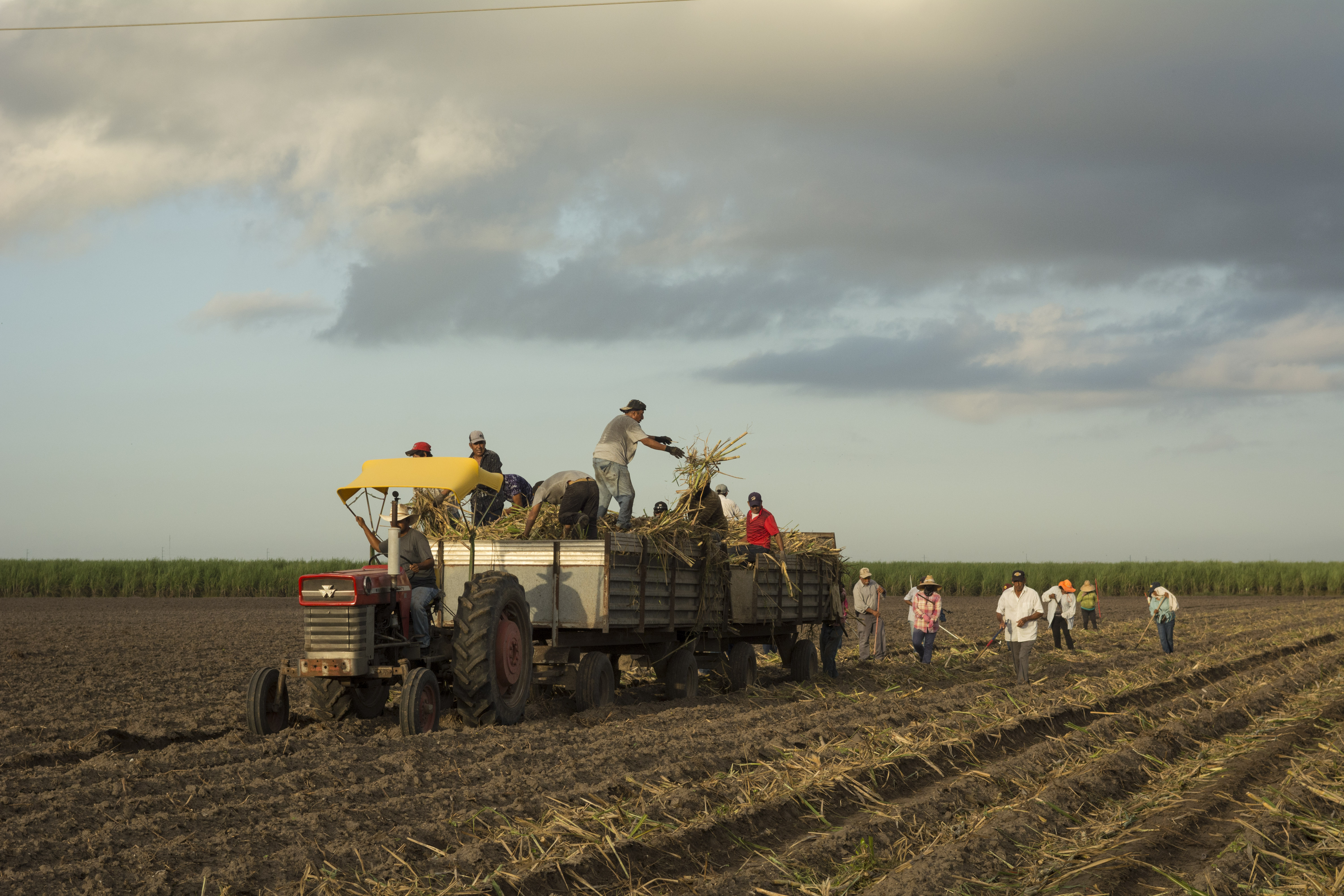
(Photo: Jerry Redfern)
One night, at his kitchen table, Reyes sketched a picture of the machine that picks asparagus in Michigan: a tractor with “wings,” where workers sit with legs outstretched, backs hunched, arms reaching for stalks to snap between their fingers as the vehicle moves through the field. Reyes said it’s like trying to touch your toes, all day long. “And you are snapping, snapping, snapping,” he said, his hands making the motion in the air. It strains the fingers. But if workers miss a stalk, it grows bigger by the next day, and then it’s even harder to snap. It twists your fingers. It hurts even more.
The worry and the work have been stressful for Reyes. Sometimes, he choked as he talked, struggling to catch his breath. In the summers, he said, he’s constantly wet from the damp of the Michigan fields, and he can’t shed the smell of asparagus when he goes home. It clings to his clothes and skin. He leaves caked in dirt and sweat and that asparagus stink. If he goes to the store, he might get stares from the other customers. “Sometimes we’ll eat in restaurants,” Reyes said, “and they don’t want us to sit all dirty next to the people that are eating the food.” So the restaurant host will seat the family in a separate part of the dining room. “We get it,” he said. “But just try to be a little more gentle. Try not to judge the people that are doing your food.”

By doing, Reyes means producing. Digging, hoeing, picking, plucking, snipping, snapping, lugging, and loading—all the sweating and toiling it takes to get a single meal to your plate. “We as consumers have a responsibility to recognize that there’s a price to pay for what we consume,” says Bobbi Ryder, former president and chief executive officer of the National Center for Farmworker Health in Buda, Texas. That price goes far beyond dollars and cents in the checkout lane. It ultimately affects the long-term health and well-being of those who work to feed America.
It used to be, according to food guru and journalist Michael Pollan, that food was politically “invisible.” No more. The food movements sweeping the U.S. and beyond have made food justice into a topic of social concern. Their swath is wide, arguing for everything from animal welfare to sustainable farming practices, locally sourced ingredients to urban-grown crops, food safety to food sovereignty, crop diversity to soil health, water conservation to wildlife preservation, feedlot ethics to Farm Bill reform. But where, in that wide net of attention, is farmworker health and well-being?
Consumers will pay a premium for cage-free eggs, free-range chicken, rBGH-free milk, pesticide-free peaches, GMO-free corn. Labels tell us which salmon is wild-caught, which tuna is dolphin-safe. They tell us when our meat is “certified humane” and “animal-welfare approved.” But who tells us no migrant was harmed in the process of securing our food, no child was deprived of an education to lower our cost? Andrea Delgado, legislative director for healthy communities at the California-based non-profit Earthjustice, says we need a fair farmwork label to say, “This product came to you, and no worker was made ill or injured or poisoned before it got to you.”
Some organizations are aiming for just that. The Washington, D.C.-based Equitable Food Initiative, for example, includes labor conditions along with food safety and pest management in its standards for produce with the EFI label. Since 2014, EFI has certified 13 farming operations in the U.S., three in Canada, 14 in Mexico, and one in Guatemala. It’s a positive step but a small one. For the most part, farmworkers continue to be left out of the equation—merely “an afterthought”—when their health and well-being should be central to equitable food debates, says Flores López of East Coast Migrant Head Start Project. Higher wages could make all the difference—but “companies keep trying to scare people: If we pay people a fair living wage, it’s going to skyrocket prices,” she says. “In reality, it’s not. It’ll be pennies to the pound.”
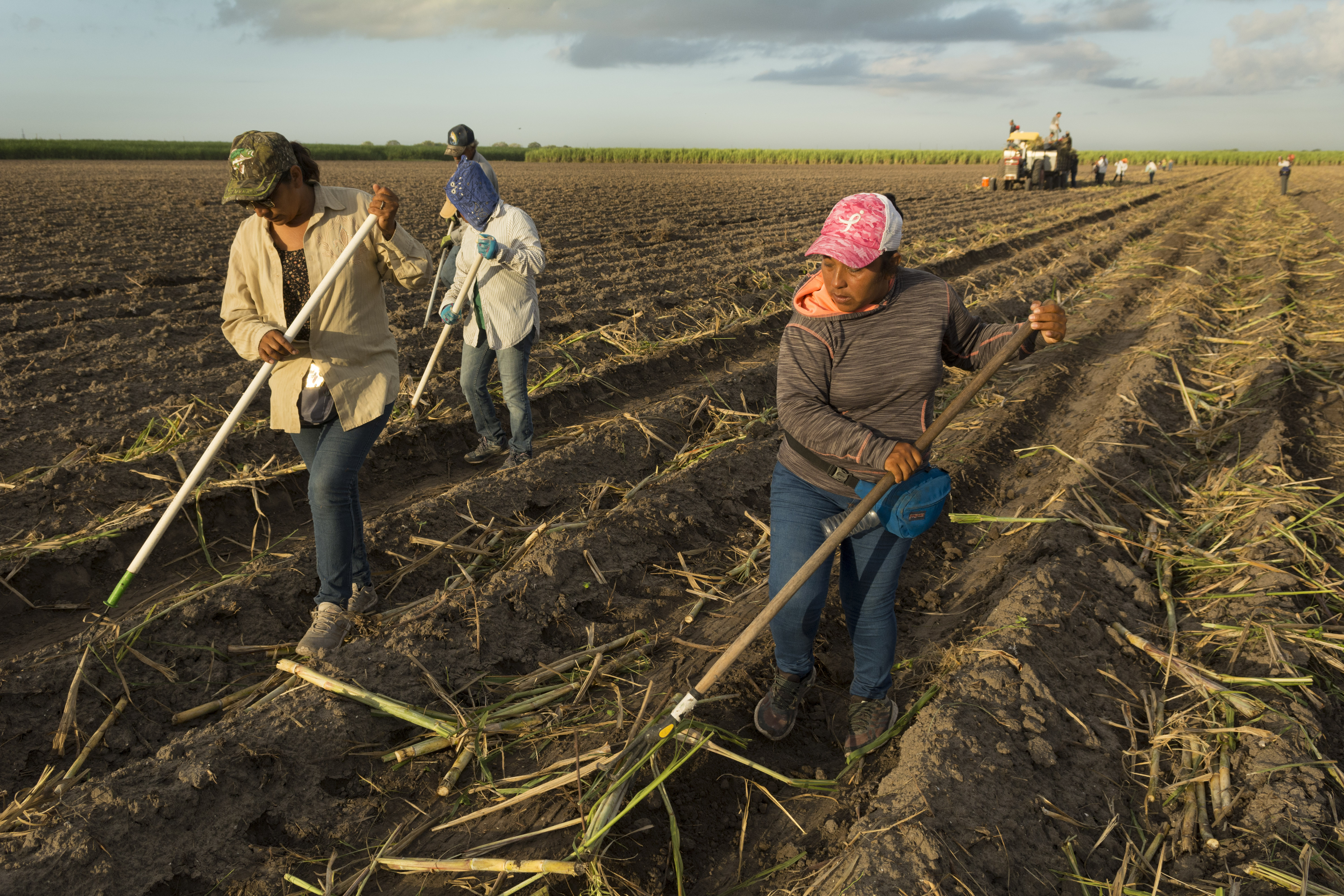
(Photo: Jerry Redfern)
Philip Martin, a labor economist at the University of California–Davis, has gathered research showing that farmers typically receive such a small share of the grocery store price (between 28 percent and 38 percent for fruits and vegetables in 2015) that even a sizable jump of 40 percent in labor costs would result in minimal increases to the consumer. Just $21 per consumer each year, based on 2017 numbers, would bring farmworkers above the poverty line.
Without those wages, something else plagues many farmworker homes: “Hunger,” says Ann Williams Cass, the executive director of Proyecto Azteca, a non-profit that helps families in colonias (temporary neighborhoods that can lack basic services such as electricity and plumbing) and rural areas. “The food insecurity is over 81 percent compared to a national average of 18 percent.” She refers to an October of 2017 report, written by physicians (with the help of Proyecto Azteca) at Children’s Medical Center in Dallas and Yale New Haven Children’s Hospital, that notes a host of long-term conditions related to inadequate nutrition among residents of rural colonias in the Rio Grande Valley region, including malnutrition, obesity, and diabetes. The bitter irony is that, many times, the very fruits and vegetables that they are harvesting are unaffordable for farmworkers.
Likewise, for farmworker mothers like Mireya, who works with her husband and children, Berenise and Salvador, in the onion fields, it’s challenging to keep on top of the meals for her children, ages two to 19. Most days, she wakes around 4 a.m. to prepare oatmeal for the younger ones before she goes to the fields. At night, she gets back as late as 6 p.m. She cooks something fast, but if she doesn’t have time, she picks up chicken from the fast-food restaurant Church’s and takes it home. Like many of their neighbors’ houses, theirs is a perpetual work in progress, added to and improved upon step by step as the family accrues money. The kitchen is spacious, and the sink rests in a homemade wooden counter. The front door has no knob, the trim isn’t finished, but many walls are painted. Berenise, her brother and sister, and sometimes her parents, all sleep in one bedroom with air conditioning. A couple of big mattresses are shoved together, one with a sheet, the other without. Salvador Sr. bought the land 15 years ago, paid for electric and septic, and has assembled the house, piece by piece, ever since. His aspirations are obvious, but a lack of money constrains him.
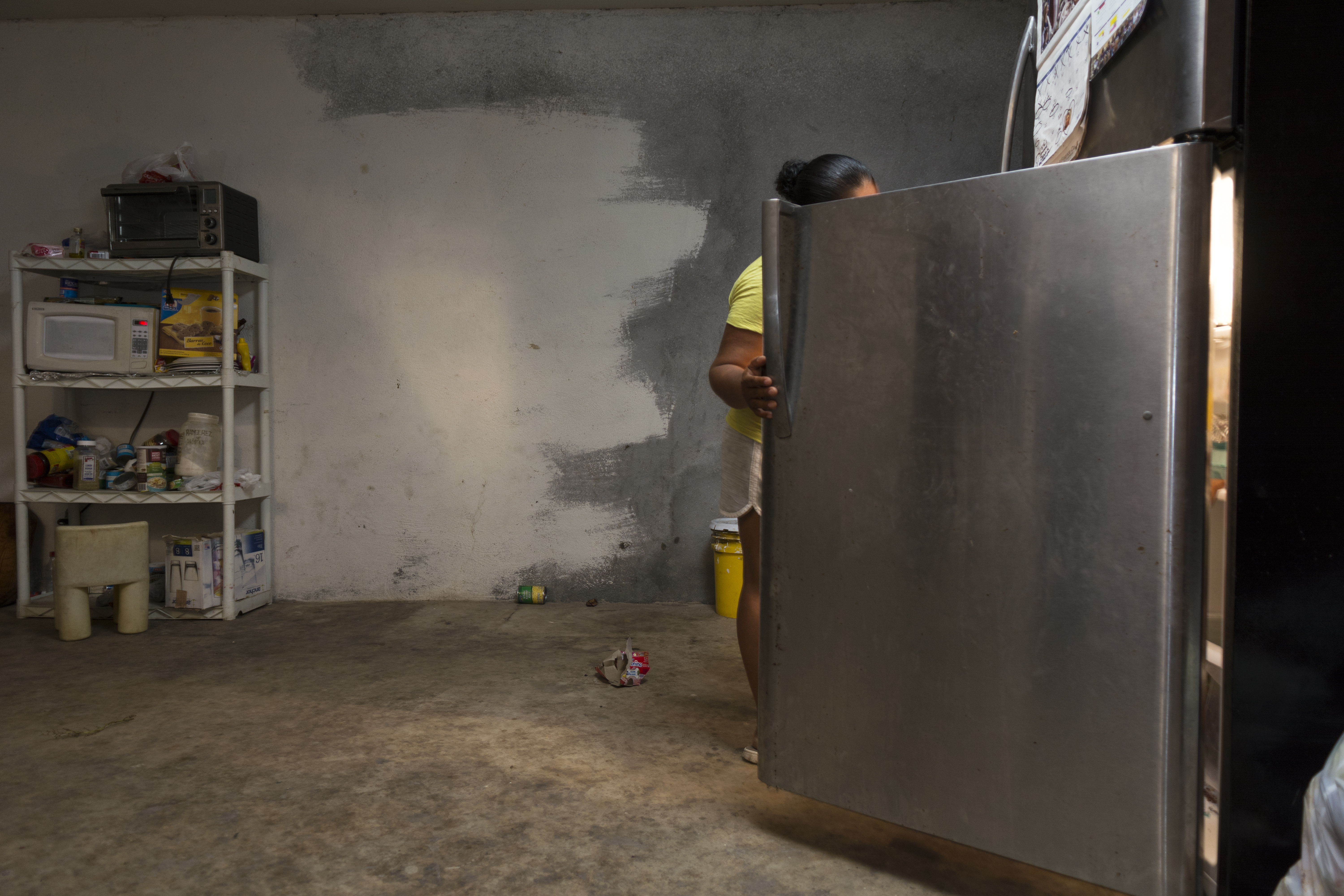
(Foto: Jerry Redfern)
Their neighborhood, like many colonias, is in a rural area far from any grocery store. So a lot of colonia residents rely on corner shops selling chips, Coke, and other junk food.
“If they have a gallon of milk that they could have gotten at the grocery store for $2, the little drive-through is selling it for $5,” says Amber Arriagas-Salinas, Proyecto Azteca’s assistant executive director. “I know mothers that just don’t eat, and they try to stretch every dollar.” Local schools offer a year-round meals program, she says, and it’s good that the children have that assistance. “But we should really be asking why the parents cannot afford to feed their children, and the reality is that we don’t have well-paying jobs.”
Maybe a slight increase in prices at suburban mega-groceries wouldn’t solve all of these problems. But Bobbi Ryder and other farmworker advocates say it’s time for middle-class grocery store patrons to start seeing themselves not just as consumers but as drivers of an economy with real-world consequences. “It’s not like any one person sets out to abuse another person,” Ryder says. “Decades and decades and decades of practices and laws led us to the position where this is the population we keep perpetually in poverty.” And yet, today’s persistent inequities are unmistakable. Everyone must eat, but not everyone is forced to reckon with what it takes to grow an onion or to pick a beet or to snap a stalk of asparagus for the tidy, tied bundles in the produce section.

Reyes is determined to finish his education. He wants to become an architectural engineer and to build a better house for his mother. Most of all, he wants to break the cycle of poverty. In May, before he packs his things for the trip to Michigan, he meets with Roberto García, Edinburg High School’s migrant counselor. It’s García’s job to make sure every migrant student in the school—some 131 kids—knows what they have to do to complete their credits for the semester, or they risk repeating the academic year and delaying graduation. Roberto is balding, his hair turning white. He wears a suit every day and a silver ring with a golden cross. Many of the kids don’t know that he started life right where they are now, so over and over, for years, he has told his students, “Never forget where you come from.”

(Photo: Jerry Redfern)
Roberto was born in 1951, the 18th child of 21. Each spring, his family would migrate north to places like Michigan and Ohio. Some of his siblings were old enough to drive big trucks, and they’d travel in two or three of them at a time, with tarps in the back and six or seven families along for the ride. His father was a mayordomo, a supervisor of the fields. “The more hands he had, the more money he would make,” Roberto said. This routine repeated itself each year, and on a couple of trips, Roberto remembers a time his mother was pregnant, about to give birth. “My dad would literally have to pull over and take everyone off the truck. And when we would hear that baby crying—waaahhh—two or three hours later, they would put us back in the truck, and we would continue.”
For months, his family would live in terrible conditions, in barracks that were “infested with rodents” (though his family worked to keep their living spaces clean). Then, in October, they’d all return to Texas, after months away from school. Roberto’s siblings were teenagers but still in elementary school because of all the school they had missed. Embarrassed, the García children stopped going to school—all of them except Roberto. “I kept on telling them, ‘You know what guys? Education is our only ticket to success. Mom and dad don’t have anything to leave us. We need to educate ourselves.'” It didn’t work. Two of his brothers wound up dead at an early age—”because of drugs,” Roberto said—and another was in prison for 36 years. “It breaks my heart to not have seen my brothers and sisters finish school the way I did.”
In fact, most of the kids in his neighborhood in Edcouch, a town 13 miles from Edinburg, didn’t go to school at all, and the migrant program didn’t yet exist. Roberto remembered that school counselors in his hometown discounted Latino students like him, telling them they were expected to join the military. Physical punishment from teachers and principals was the norm. Roberto recalled that bad weather meant “horrible days” at school because the students would eat inside rather than outside on the playground. The kids who could afford the 25-cent lunch tickets would go to the cafeteria. Then the teacher would ask, “How many of you brought lunches?” Some of the kids would raise their hands. “How many of you brought sandwiches?” Kids with sandwiches could remain in their seats. “How many of you brought tortillas?” All of those kids were ushered to the back of the room, behind the coat racks and away from the rest of the class.
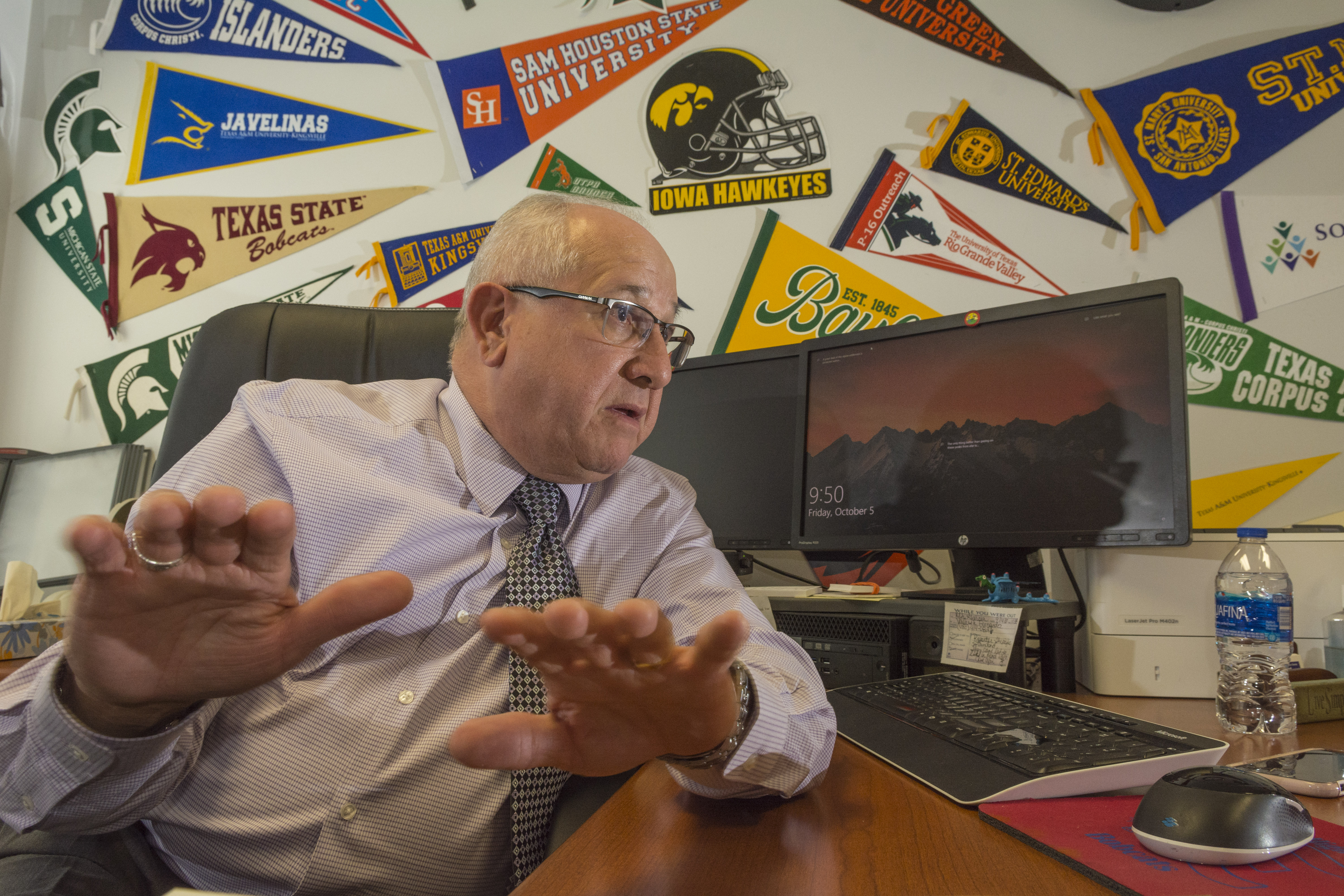
(Photo: Jerry Redfern)
Today, Roberto sees a lot of himself and his siblings in his students at Edinburg High, and he does his best to make sure they get their education. But old problems persist. “So in Georgia they were a little racist, so they didn’t want me in the school,” said 15-year-old freshman Charito Talavera. Her black hair was pulled back in a ponytail. It was October 8th, and this was her first meeting with Roberto. “So they would say that they lost my paperwork. I didn’t go to school over there for like three months. So when I did go to school, I was there for about a week before I moved,” she said.
Roberto leaned over a red folder with her records and told her that he would fight for her. Charito travels with her mother and stepdad, but she doesn’t work. Nationwide, nearly 10 percent of the 300,000 children eligible for the K-12 Migrant Education Program in 2016–17 were not enrolled in school, according to the latest numbers by the Department of Education. Their constant movement makes it challenging for school counselors to keep track of students’ credits toward graduation, and kids often wind up in the wrong classes. Sometimes, they skip school or simply drop out. The federal Migrant Education Program, started in 1966, provides funds to states to help identify and assist students who qualify, but it’s not always easy, even with federal funding and the support available from counselors like Roberto. According to Texas Education Agency data, only 70.7 percent of migrant farm students who started in the ninth grade in the Edinburg Independent Consolidated School District graduated in the class of 2017. That rate is significantly lower than the graduation rate of immigrant students and economically disadvantaged students statewide.
Still, there’s room for hope. Roberto loves to brag about Leslie Limas Treviño. Her family started taking her to Eldora, Iowa, when she was two months old. And because she only spoke Spanish at home, she arrived for kindergarten speaking no English. For years after, she spent half the year away from Texas, jumping in between schools. But she graduated in 2006 and went on to become a registered nurse. Leslie is 30 now and still travels every summer with her husband, who works in the fields, just as her parents do. They take their three-year-old son and five-month-old daughter. That’s a specific choice she makes, even though the children can’t work and they’re too young to understand. “They need to know the value of things by knowing where everything comes from, and where they come from,” she says.
When Roberto started in 2002, he says, there were roughly 5,000 migrant students in his district. Today, that number is down to about 1,600. That change is noticed by farmers like Max Schuster, vice president of operations of Val Verde Vegetable Co., a multigenerational family owned farm. Some of his workers used to bring their 16- to 18-year-old children to work on weekends or after class, but he doesn’t see them as much these days. “The parents are kind of telling them: ‘Is this what you want to do for the rest of your life? Or do you want to get an education, provide more for your family?'”
Roberto knows that’s often easier said than done. As he reviewed Charito’s red folder, he noticed she had lots of absences, and she was struggling in her Spanish class. But it was OK, he said, she still had time to make up for it; he would talk to her teachers if she wanted him to. Before she left, Roberto encouraged her to join the migrant club.
“If you don’t do it, I’m gonna look for you, girl,” he said. “You would be a very good officer in the club. You really would. I could see that quality about you.”

It was 6:30 a.m., and a sliver moon hung in the pitch-black sky over Berenise’s house in Weslaco. A pick-up truck idled in the driveway as Salvador Sr., Mireya, and their son-in-law prepared for another day planting sugarcane. This job pays by the hour, not the piece, and it’s too dangerous for kids. So Berenise and the younger Salvador slept through the morning. It was the elder siblings’ job to care for their two-year-old brother that day. That was part of their contribution to the family, Salvador Sr. said.
Salvador Sr. drove slowly through the dark, at times 15 miles below the limit. He’d been pulled over a couple of times at traffic stops, and he said he had always been honest with the cops. “I just show them my Mexican ID and tell them the truth: I don’t have papers. But I have insurance on my car.” He’s been lucky so far.
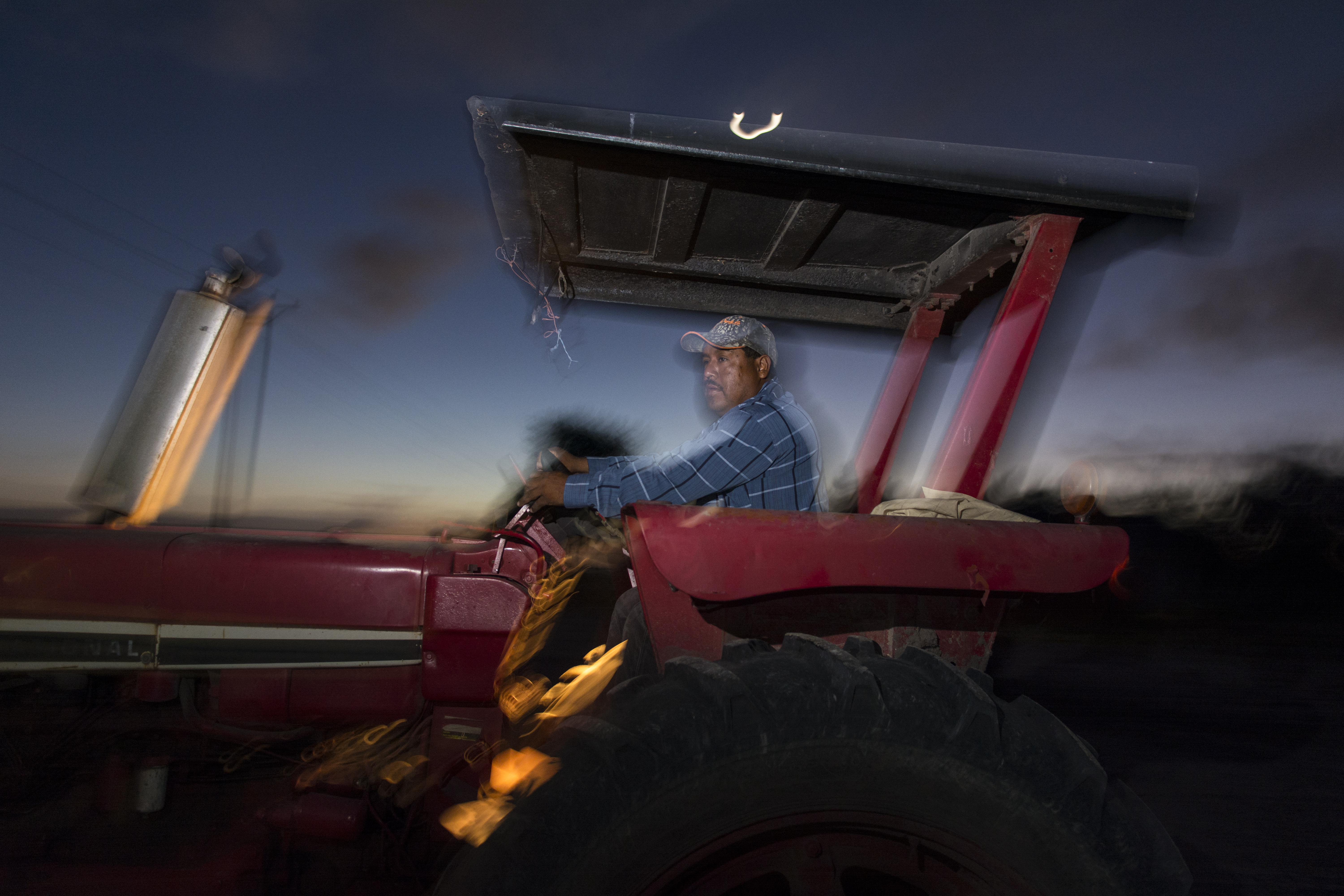
(Foto: Jerry Redfern)
By the time Salvador hopped on his tractor, sunlight illuminated giant clouds in a sky of pink, peach, and birdshell blue. All around was a mash-up of urban and rural sounds: crickets, frogs, dogs, highway traffic, roosters, and radios. The tractor was hitched to a couple of long, rectangular trailers piled high with cane. A couple of workers hung an orange Home Depot water cooler from one of the trailers, along with a stash of paper cups.
A dozen or so of the most resilient men hopped atop the piles of sugarcane. Some wore gloves and heavy-duty hats, gripping long, metal poles with curved picks made of rebar, which they used to roll the sugarcane to the ground as the tractor moved ahead. One of the workers, Manuel Salazar, bit on a piece of cane and chewed it. It would later help to quench his thirst. He knew, by afternoon, it would get so hot he’d feel sick.
“The tractor jumps and jumps all day long,” Salvador said. “But once you’re used to it, it’s a better exercise than Zumba.”
Time passes faster with a sense of humor. Mireya, too, likes to tease her co-workers atop the trailer. “Échele caña, Nicolas, échele caña,“ she said, urging him to keep up the pace. By 8 a.m., the sun was barely up, but the air was already hot and sticky. The humidity rose from the ground. The trailers moved back and forth, back and forth, hour after hour, across a field that seemed to touch eternity. ❖
This story was reported with a grant from the International Women’s Media Foundation.

Authors: Karen Coates is an independent journalist, author, editor, and media trainer based in New Mexico. She primarily covers food, environment, health, and human rights, and specializes in telling stories from the ground up. She is a fellow at the International Women’s Media Foundation and president of the Society of Professional Journalists’ Rio Grande Chapter.
Valeria Fernández is an independent journalist from Uruguay with more than 16 years experience as a bilingual documentary producer and writer on Arizona’s immigrant community and the U.S.–Mexico borderlands. She is a fellow at the International Women’s Media Foundation, and, in 2018, she was the inaugural recipient of the Mosaic Award for her reporting on underrepresented communities.
Photographer: Jerry Redfern is an award-winning visual journalist, covering environment, health, and human rights, primarily in the developing world. He was a senior fellow at the Schuster Institute for Investigative Journalism until it folded earlier this year, and was a 2012–13 Ted Scripps Fellow in Environmental Journalism at the Center for Environmental Journalism at the University of Colorado–Boulder.

Editor: Ted Genoways
Researcher: Jack Herrera
Picture Editor: Ian Hurley
Copy Editor: Leah Angstman
This story is part of the Unseen America project, stories about the struggles and challenges being faced by the misunderstood middle of our nation.





